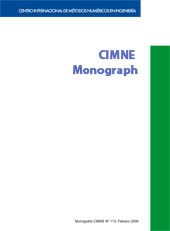Numerical Simulation of Multi-Fluid Flows with the Particle Finite Element Method
FREE!
ISBN: 978-84-96736-87-0
Editorial: CIMNE
Year of publication: 2010
Pages: 178
Index: Introduction; Multi-fluid flows; PFEM for multi-fluid flows; Geological applications
ISBN: 978-84-96736-87-0
Editorial: CIMNE
Year of publication: 2010
Pages: 178
Index: Introduction; Multi-fluid flows; PFEM for multi-fluid flows; Geological applications
Description
In this monograph we have focused on understanding the basic physical principles
of multi-fluid flows and the difficulties that arise in their numerical simulation. We have extended the Particle Finite Element Method to problems involving several different fluids with the aim of exploiting the fact that Lagrangian methods are
specially well suited for tracking any kind of interfaces. We have developed
a numerical scheme able to deal with large jumps in the physical properties
(density and viscosity), include surface tension, and accurately represent all types of discontinuities in the flow variables at the interface. The scheme is based on
decoupling the nodes position, velocity and pressure variables through the Picard
linearization and a pressure segregation method which takes into account the interface conditions. The interface has been defined to be aligned with the moving mesh, so that it remains sharp along time. Furthermore, pressure degrees of
freedom have been duplicated at the interface nodes to represent the discontinuity of this variable due to surface tension and variable viscosity, and the mesh has been
refined in the vicinity of the interface to improve the accuracy of the computations.
We have applied the resulting scheme to several academic and geological problems,such as the two-fluid sloshing, extrusion of viscous fluids, bubble rise and breakup,mixing of magmatic liquids and negatively buoyant jets.

